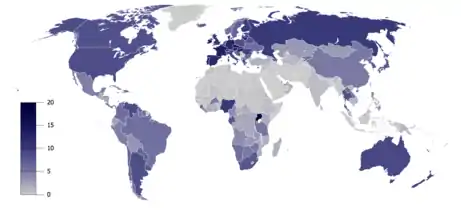Alcohol in Australia
Alcohol is commonly consumed and available at pubs and liquor stores in Australia – all of which are private enterprises. Spirits can be purchased at liquor stores and pubs, whereas grocery stores do not sell them, although they may have separate liquor stores on their premises. Alcohol consumption is higher, according to WHO studies, than in most European countries and several Central Asian and African countries, although consumption is just as high in Australia as in North America.[1] After tobacco, alcohol is the second leading preventable cause of death and hospitalisation in Australia.[2]
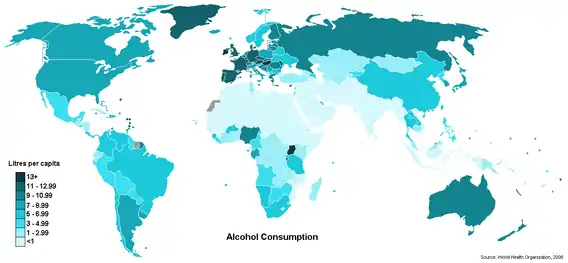
Alcohol is served in many social and recreational situations, and its use is often encouraged. While drinking alcohol is often seen as intrinsic to Australian culture, the effects associated with over-consumption don't just affect the individual, but also the wider national community. In 2012, it was estimated that Australians spent $14.1 billion each year on alcohol.[3]
History
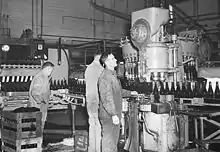


Heavy drinking in Australia was a cultural norm since colonisation.[4] For a period, convicts in Australia were partially paid with rum.[4] The distribution of rum amongst the New South Wales Corps led to the only successful armed takeover of an Australian government, which later became known as the Rum Rebellion of 1808.
Spirits were the most widely consumed alcoholic beverages in Australia in the 1830s, with early conservative estimates showing that 3.6 litres of pure alcohol were consumed by each person in NSW annually.[5] In the 1830s, the Temperance Movement gained a following in the colony. Its influence peaked during World War I and the Great Depression. Alcohol sales were prohibited in the Australian Capital Territory between 1910 and 1928. Four referendums regarding the prohibition of alcohol were conducted in Western Australia, including one in each of the years 1911, 1921, 1925 and 1950. In 1837, laws were passed to prevent Aboriginal access to alcohol as binge drinking became problematic.[6]
An attempt to prohibit alcohol on the Victorian Goldfields was made in 1852.[6] This was the main factor leading to the growth in sly-grog shops.[7]
In a failed attempt to reduce the effects of alcohol on society, all liquor establishments were forced to close by 6 pm from the 1910s to the 1960s. Rather than reduce alcohol consumption, the measures led to excessive drinking in the hour before closing time which became known as the six o'clock swill.[6] In the decade after World War II there was a steep rise in the consumption of beer in Australia.[8] Since the 1960s the popularity of beer has declined while wine consumption increased.[2]
The consumption of alcohol increased from the mid-1960s to the early 1980s when it began to decline until it reached a consumption level commensurate with 1961 in 2003.[9] Consumption peaked in 1974 and 1975 when an average of 13.09 litres of pure alcohol was consumed.[2]
In March 1965, Merle Thornton and Rosalie Bogner secured themselves to the foot rail of Brisbane's Regatta Hotel with a dog chain to protest laws excluding them, as women, from drinking with men at public bars.[10] In 1965, a South Australian winemaker Thomas Angove, invented the box wine or wine cask.[11] The following four decades saw an increase in per capita wine consumption and a decrease in beer drinking.[9] However the market value of beer sales increased as the sales of up-market or boutique beers gained in popularity.
In 2005, Queensland introduced a lockout trial in order to reduce alcohol-related violence at three entertainment precincts which saw patrons barred from re-entering a licensed venue after 3 am. Victoria introduced a similar initiative known as the 2am Lockout in 2008. The 2010 Melbourne live music rally was a public rally to protest the claimed effects of liquor licensing laws on live music in the city.
Production and consumption
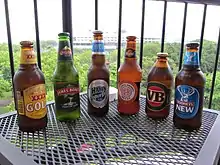
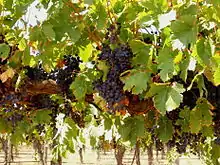
Alcohol is the most widely consumed drug in Australia and is frequently available at social and cultural activities.[12] On a per capita scale, 10.3 litres of pure alcohol were consumed by each Australian in 2010. The average amongst OECD countries was 9.1 litres. Beer was the most preferred beverage, followed by wine, spirits and pre-mixed beverages.[12] Retail sales for alcohol including GST in the 2011/12 financial year totalled A$18,135 million.[13] In 2012, XXXX Gold was Australia's top-selling as measured by the volume of sales.[14]
In 2010, the National Drug Strategy Household Survey found that 7.2% of the Australian population drank alcohol each day.[15] Males were found to drink on daily basis at twice the rate of females and were more likely to drink quantities which posed a health risk. One recent survey of teenagers in Australia has shown a decrease in binge drinking across the age group since 2005.[16] Another survey in Victoria revealed drinking rates were increasing for young people despite it being illegal.[17] In 2010, 18- to 29-year-olds were the age group most likely to drink at harmful levels.
There are numerous factors that contribute to the rate of alcohol consumption in rural Australia. Studies have found a variety of economic and social factors result in a higher rate of alcohol consumption. Economically, factors such as lower income, level of education, lack of infrastructure, and a higher availability of alcohol are all known to affect alcohol consumption rates. Social factors also play a large role with the normality and social acceptability of alcohol consumption in rural areas often leading to drinking beginning at a much younger age. Gender has also been found to play a large role in rural communities, with a sense of masculinity seen to heavily influence people.[18]
Drinking age
In Australia, 18 is the legal age at which someone may purchase alcohol. Many leading health experts claim young peoples' brain development are still vulnerable to alcohol's toxicity at the age of 18. Liquor outlets across Western Australia are required to request identification from those who look under 25 years of age when purchasing alcohol. Police cadets, most of whom are around 24 years of age, are often used to research retailers who would sell them alcohol. In 2013, 72 out of 100 cadets were able to purchase alcohol without showing identification in the Perth metropolitan area.[19] The National Health and Medical Research Council issues guidelines for alcohol use in Australia.
| State/territory | Current legal
drinking age |
Year adopted | Previous legal drinking age |
|---|---|---|---|
| Australian Capital Territory | 18 | 1928 | Not amended |
| New South Wales[20] | 18 | 1905 | Not amended |
| Northern Territory | 18 | 1929 | Not amended |
| Queensland | 18 | 1974 | 21 |
| South Australia | 18 | 1971 | 20 in 1968 |
| Tasmania | 18 | 1974 | 20 in 1967 |
| Victoria | 18 | 1906 | Not amended |
| Western Australia | 18 | 1970 | 21 |
Society and culture
Alcohol plays an integral part of Australian culture. Alcohol plays a role in celebrations, a variety of social activities, relaxation, as a generator of tax revenue and as a major source of employment and exports.[21]
A common cultural staple amongst young people is to drink, specifically, to get drunk. Almost two-thirds of 18- to 29-year-olds agreed with this statement, and one in five hospitalisations of people under 25 was alcohol related.[22] 88% of Australians surveyed in 2010 had consumed alcohol by age 14. Of Australians who do drink often, the majority seem to do so in moderation. 72.6% of those surveyed consume alcohol below levels for long term risk of harm. However, many Australians consume alcohol at harmful levels. There are more than 42 million incidents of binge drinking each year. Each month 20.4% of Australians consume alcohol at high risk levels.[21] Australians living in remote areas are more likely to drink at high risk levels compared to those living in urban areas.[23]
The driving forces behind Australia's drinking culture are derived from social customs, habits, publicised images and normality. These factors can be enhanced by influences related to the social, physical and economic availability of alcohol. This is driven by marketing and promotion, cost, accessibility and age restrictions. There is no single factor attributed to why people drink at these harmful levels, however lack of nutrition, poor exercise, smoking, damaging health behaviours, illicit drug use and excessive drinking all appear to contribute to a complicated structure of social determinants.[21]
Many Australians feel the need to consume large amounts of alcohol before going to public venues to socialise and continue drinking. This is commonly known as "pre-drinking". This is largely due to the views many have of the elevated cost of alcohol purchased at venues. The dangerous levels of intoxication being widely accepted in Australia points to a problem with alcohol consumption. Social networking has also been studied as having undergone negative effects when combined with overconsumption of alcohol.[24]

Etiquette
What mostly attracts Australians to drinking is the taste of the beverages as well as general social acceptance. Social norms have been created as a result of communal drinking. When everyone has finished their drink, one member of the group is expected to purchase the next "round" of drinks until all members of the party have paid one turn. "Shouting" refers to paying for someone else's drink as a good gesture with no expectation of one in return.[24] This can give people the feeling of being more socially accepted.
Influences
Peer pressure
A lot of pressure can be placed on someone who feels that there is a social expectation to consume alcohol. It's more often than not referred to as being "un-Australian" to turn down an alcoholic drink. This places a considerable amount of pressure on young people in particular. Learning how to drink is often thought of as an integral part of growing into adulthood.[25] This peer pressure maintains the social norm, and wider acceptance of the drug.
Social occasions
In many social situations alcohol is more than likely available. It is expected that alcohol be available at numerous social events including household parties, pubs, clubs, sporting events, during meals, celebrations and even funerals.[26]
Social status
A lot of people think drinking alcohol gives them a sense of identity that may help them fit in with social networks. Some also believe it heightens confidence to take part in social situations.[26] Some may oppose the fact that they are being pressured into consuming alcohol, but others look to find social networks where consuming alcohol is common as enhancing a sense of belonging and identity formation.[27]
Family
Children's first reference for alcohol can be traced to their parents habits. 62% of underage Australians said they got access to their alcohol from friends or others, while 44% said their own parents purchased their alcohol. Nearly one in ten managed to purchase alcohol themselves.[26]
Marketing
Marketing campaigns have heavily influenced the change in the type of alcohol consumed extensively by young people. Premixed spirits are the focus of many advertisements, rather than beer or wine. The alcohol content in these premixed drinks are of concern as they hold higher alcohol percentages than the same amount of beer. Many young people prefer these drinks because they are often sweet and disguise the amount of alcohol they contain.[27]
Binge drinking
Alcohol is a major contributing cause of violence in Australia. In 2006, more than three-quarters of a million Australians were abused by persons under the influence of alcohol, including 33,147 cases in NSW.[28]
Young people
According to the National Binge Drinking Campaign on Young Australians and Alcohol, more than 20% of 14- to 19-year-olds consume alcohol on a weekly basis. In 2005, the Australian School Students' Alcohol and Drug Survey found that 10% of 12-year-olds had consumed alcohol in the week prior to the survey, and amongst 17 years old, this increased to 49%.[29]
According to the 2007 National Drug Strategy Household Survey (NDSHS), 82.9% of Australians aged 14 and over had consumed alcohol in the previous 12 months, with only 10.1% having never consumed at least 1 standard drink of alcohol. The survey also found that 20.4% of Australians (23.7% of males and 17.2% of females) consumed alcohol at risky or high risk levels according to the 2001 Australian guideline for Alcohol intake. In March 2008, Prime Minister Kevin Rudd announced the allocation of $53 million in funding to target what he described as a "Binge-Drinking Epidemic" among young adults in Australia.[30] Among teenagers who drink weekly, 29% of males aged 12–17 had consumed seven or more drinks on one occasion; and 32% of females in the same age group had consumed five or more drinks at the same time.
Approximately 40% of 14- to 19-year-olds drink at levels that risk harm in the short term, like accidental injuries.[31]
Indigenous alcohol consumption
Statistics show that the rate of binge drinking in rural areas is 5% higher for indigenous Australians when compared to the non-indigenous, and it was also found that indigenous Australians were twice as likely to consume alcohol dangerously in the short term at least once a week. Australian Institute of Health and Welfare found that the rate of alcohol abstention for both male and female indigenous Australians was much higher than non-indigenous Australians, sitting at 1.7 and 1.4 times more respectively. While the rate of alcohol abstention is high, the rate of both short- and long-term risky drinking in indigenous Australians causes some concern.[32]
Indigenous Australians were prohibited from buying alcohol until the end of the 1960s. The repeal of this legislation saw a rapid increase in indigenous alcohol consumption and contributed to many of the problems faced by indigenous Australians today. In recent years, efforts have been made to try to curb indigenous drinking, with the Queensland government, in association with rural indigenous communities, setting up Alcohol Management Plans (AMPs). AMPs were first introduced in Australia in 2002, and have been adopted throughout a number of states.[33] More recently, AMPs have been introduced into 19 communities in rural Queensland to attempt to control alcohol-fuelled violence. The plans either restrict the type and amount of alcohol that can be purchased in a town, or involve a blanket ban on alcohol sales.[34]
There has been a noticeable decrease in alcohol-fuelled violence and dysfunction in the communities that have faced alcohol bans and restrictions. In 2012 the newly elected Queensland state government, under premier Campbell Newman, proposed a winding back of the alcohol restrictions; a number of aboriginal elders and community leaders opposed these changes, citing the positive benefits brought about by the laws.[35] Despite the many positives that alcohol bans have brought to indigenous communities, issues with alcohol consumption still exist, mainly the issue of home brewed alcohol. Home brew alcohol is commonplace in many of the indigenous communities where alcohol has been banned, with recent reports also calling for a ban of popular spread vegemite, because of its reported use in the manufacturing of alcohol in some northern territory communities.[36]
Binge drinking in Indigenous communities

In 1837, laws were passed to prevent the sale of alcoholic beverages to Aboriginal Australians, as binge drinking became a problem in indigenous communities.[37] Despite this, alcohol was often purchased illegally and there was a trend of rapid consumption of high alcohol content beverages. This style of consumption perpetuated the binge drinking cycle. Aborigines were over-represented in arrests for drunkenness during the period, and continue to be over-represented. Aboriginal people were given the right to drink alcohol in the various states and territories between 1957 and 1975, a right which, for many aborigines, became a symbol of equality, citizenship and status.[38]
Marketing
In 2007, it was reported that $128 million was spent on alcohol advertising in Australia.[39]
The Australian Medical Association claims young people in Australia are being exposed to an unprecedented level of alcohol marketing.[40] While there are no alcohol advertising bans in Australia some restrictions and conditions apply.[39] There are no restrictions on the sponsorship of youth and sport events in Australia.[41]
Legislation and guidelines
The age limit for the purchase of alcoholic products in Australia is 18. A license to both produce and sell alcohol is required. Alcohol products in Australia contain warnings against drinking whilst pregnant. Guidelines for alcohol use are made by the National Health and Medical Research Council.[12] The body recommends no more than two standards drinks per day to avoid life-time risk of harm from an alcohol-related injury or disease.
Queensland has introduced alcohol restrictions as part of the state's Alcohol Management Plans in 19 separate Indigenous communities.[42]
Violence and harm
Alcohol abuse in Australia is associated with violence, drink driving, child neglect and abuse as well as absenteeism in the workplace.[12] Alcohol is second to tobacco as the cause of preventable death and hospitalistion in Australia. According to a report released by VicHealth and the Foundation for Alcohol Research and Education in 2014, an average of 15 Australians die each day due to alcohol, an increase of 62% within a decade.[43] One recent estimate of the total cost of alcohol-related crime put the figure at $1.7 billion.[44]
A broad range of negative effects come with excessive alcohol consumption. Some of these include an increase in road and other accidents, crime, public and domestic violence, brain damage, liver disease, and the breakdown of social networks.[27] Alcohol related police detentions account for approximately 39% of all crimes.[24] Alcohol consumption relates to one in eight deaths of Australians under the age of 25.[45] In 2013 five million Australians aged 14 or over (26%) reported being victim to an alcohol related incident.[46]
According to the 2010 National Drug Strategy Household Survey just over 8% of Australian adults reported being the victim of an alcohol-related assault.[47] Between 2004 and 2008, Indigenous Australians died from disorders due to alcohol at a rate seven times greater than non-Indigenous Australians.[12] Estimates obtained from police data show 70,000 Australians were the victim of an alcohol-related assault in 2005.[12][48] Research has indicated about 10% of police time is devoted to dealing with incidents related to alcohol.[44]
In an effort to reduce alcohol intoxication by teenagers during schoolies week liquor retailers have had to hire extra security staff at popular schoolies locations.[49] Parents supplying alcohol to minors in an unsupervised environment may incur penalties of up to $8,800 in Queensland.[50]
Solutions to binge drinking
There are many initiatives, mainly funded by the federal government, to help resolve the binge drinking crisis.
Drink Wise is an independent (citation needed), non-for-profit organisation founded by the alcohol industry in 2005.[51] Dozens of scientists have vowed not to accept their funding as they lack transparency and independence stating in a joint media release Drinkwise "promotes ineffective interventions rather than measures known to be effective that reduce industry profits".[52]
Its main focus claims to be help bring about a healthier and safer drinking culture in Australia. Drink Wise provides information for managing teen drinking, binge drinking, drink driving, effects of alcohol on pregnancy and for school leavers. It fights against evidence based policies such as raising the tax on alcohol.[53]
Tackling Binge Drinking is a government program supported by the AFL, which promotes a healthy alcohol culture and addresses the risks of alcohol use in adolescence, mainly surrounding sport.[54]
DrugInfo is a website run by the Australian Drug Foundation to raise awareness of harms related to using drugs, including alcohol.[55]
Public drunkenness
Victoria and Queensland are the only states that still have a specific offence of public drunkenness, a charge that a royal commission found disproportionately affected Aboriginal people.[56] In the other states and territories, a person must also be behaving in a disorderly or offensive manner to be charged with an offence.[57] On 22 August 2019, Victoria announced plans to decriminalise public drunkenness and to treat alcohol abuse as a health issue.[56]
In Victoria being "drunk in a public place" and "drunk and disorderly in a public place"[58] are separate offences contained in the Summary Offences Act 1966 which have their own power of arrest. Recent changes to legislation allow police to issue an infringement notice for these offences[59] in addition to the traditional method of charging and bailing the offender to the Magistrates' Court. The current fine attached to the infringement notice is $590 for a first offence and $1,100 for a subsequent offence.[60] A person arrested for being drunk or drunk and disorderly is held at the Melbourne Custody Centre or the cells at a police station or placed in the care of a friend or relative.
Public drunkenness was decriminalised in New South Wales (1979),[61] and the Northern Territory, and in South Australia (1984).[62] In New South Wales police have the discretion to issue "on the spot" fines or infringement notices for "drunk in public", a fine that costs the individual over $480 (4 penalty units). Community Legal Centres across the state complain about these fines and the impact it has had on various vulnerable members of the community, including young people, the homeless and minority groups. As an example, a "drunk and disorderly" fine in New South Wales starts at $550. As of February 2009, local councils in New South Wales are not allowed to charge people who drink in alcohol-free zones; they are only permitted to confiscate the alcohol of the intoxicated person.
Alcohol related organizations
The Australian Hotels Association represents hoteliers around Australia. It was established in 1839. The Brewers Association of Australia and New Zealand was set up to advocate on behalf of brewers in both countries.[63]
Drinkwise is an industry funded organisation that funds alcohol-related research and conducts public education activities. Ocsober is an Australian fundraising initiative that encourages people to give up alcohol for the month of October.
See also
References
- Global status report on alcohol and health. 2011. World Health Organization. Retrieved 26 February 2013.
- Melissa Davey & Nick Evershed (6 May 2015). "Australians' alcohol consumption at lowest level since 1960s". The Guardian. Guardian News and Media. Retrieved 8 May 2015.
- "Australian spending habits". www.moneysmart.gov.au. Retrieved 4 September 2015.
- "A brief history of alcohol consumption in Australia". The Conversation. The Conversation Media Group. 25 February 2013. Retrieved 26 February 2013.
- "A brief history of alcohol consumption in Australia". Retrieved 25 February 2013.
- Alcohol in Australia: Issues and Strategies (PDF). Commonwealth of Australia. 2001. p. 1. ISBN 0642503230. Retrieved 28 February 2013.
- "Law, Order and Health". Department of Planning and Community Development. 14 May 2012. Archived from the original on 25 June 2013. Retrieved 28 February 2013.
- Holt, Mack (2006). Alcohol: A Social and Cultural History. Berg. p. 214. ISBN 1845201655.
- Rowe, David; Callum Gilmour (2009). "Lubrication and Domination: Beer, Sport, Masculinity and the Australian Gender Order". In Wenner, Lawrence A.; Jackson, Steven J. (eds.). Sport, Beer, and Gender: Promotional Culture and Contemporary Social Life. Peter Lang. p. 206. ISBN 978-1433100765.
- "Sixties activists fought for rights with marches, bra-burning". The Courier-Mail. Queensland News. 1 June 2009. Retrieved 28 February 2013.
- Crystal Ja & AAP reporters (25 January 2011). "Eclectic mix honoured on Australia Day". The Sydney Morning Herald. Fairfax Media. Retrieved 27 February 2013.
- Australian Institute of Health and Welfare (2012). Australia's health 2012. Australian Institute of Health and Welfare. pp. 228–234. ISBN 978-1742493053.
- "The Australian Alcohol Market". Distilled Spirits Industry Council of Australia. Retrieved 27 February 2013.
- Colin Kruger (5 November 2012). "Lion leads the way with XXXX Gold". The Sydney Morning Herald. Fairfax Media. Retrieved 28 February 2013.
- 2010 National Drug Strategy Household Survey report. Canberra: Australian Institute of Health and Welfare. p. 45. ISBN 9781742491882. Retrieved 26 February 2013.
- Tony Wright (11 February 2013). "Fall in teenage binge drinking". The Sydney Morning Herald. Fairfax Media. Retrieved 25 February 2013.
- "Study shows half of Australia's 17-year-olds binge drink". The Cairns Post. News Limited. 6 February 2013. Retrieved 26 February 2013.
- Allan, J.; Clifford, A.; Ball, P.; Alston, M.; Meister, P. (4 July 2012). "'You're Less Complete if You Haven't Got a Can in Your Hand': Alcohol Consumption and Related Harmful Effects in Rural Australia: The Role and Influence of Cultural Capital". Alcohol and Alcoholism. 47 (5): 624–629. doi:10.1093/alcalc/ags074. PMID 22763230.
- "Govt and Commissioner disagree over bottle shop stings". ABC News. Retrieved 7 September 2015.
- "Laws in NSW". Archived from the original on 23 February 2016.
- Preventative Health. (2014). Changing the drinking culture in Australia. Retrieved from http://www.preventativehealth.org.au/internet/preventativehealth/publishing.nsf/Content/09C94C0F1B9799F5CA2574DD0081E770/$File/alcohol-1.pdf Archived 4 March 2016 at the Wayback Machine
- "One in eight youth deaths due to alcohol, report". ABC News. Retrieved 7 September 2015.
- Simonet, E. N. C. (2014). Problem drinking in Australia. Chisholm Health Ethics Bulletin. 19(4), 9–12. Retrieved from: http://search.informit.com.au.ipacez.nd.edu.au/fullText;dn=958247629035655;res=IELAPA
- "Australian Drinking Culture – The evolution from drunkards to connoisseurs". www.convictcreations.com. Retrieved 7 September 2015.
- (2008). Drugs in Focus. Teenage drinking: the facts and issues. Retrieved from http://www.druginfo.adf.org.au/attachments/085_DIF_teendrinking_complete_4.pdf
- "Teen Drinking Law | Young People and Drinking – How much young people drink". www.teendrinkinglaw.vic.gov.au. Retrieved 7 September 2015.
- National Health and Medical Research Council. (2015). Alcohol and health in Australia. Retrieved from https://www.nhmrc.gov.au/health-topics/alcohol-guidelines/alcohol-and-health-australia Archived 19 August 2015 at the Wayback Machine
- Goh, D (2008). "New South Wales Recorded Crime Statistics 2007" (PDF). NSW Bureau of Crime Statistics and Research. Retrieved 1 September 2015.
- The 2005 Australian Secondary Students' Alcohol and Drug Survey.
- "Rudd gets tough on binge drinking". Youth Studies Australia. 1 June 2008.
- AIHW (2007). "AIHW - 2007 National Drug Strategy Household Survey" (PDF) – via http://www.drinkingnightmare.gov.au/.
- Health, Australian Institute of; Welfare (2011). Substance use among Aboriginal and Torres Strait Islander people. Canberra, A.C.T.: Australian Institute of Health and Welfare. ISBN 978-1-74249-119-6.
- "Alcohol management plans and related alcohol reforms" (PDF). Indigenous Justice. Archived from the original (PDF) on 27 January 2016. Retrieved 4 September 2015.
- McKenna, Michael (19 June 2014). "Keeping a lid on drink". The Australian. Retrieved 4 September 2015.
- d'Abbs, Peter (12 October 2012). "New singers, old songs: alcohol bans in Aboriginal communities". The Conversation. Retrieved 4 September 2015.
- "'Vegemite watch' rejected by PM after reports spread used to brew alcohol in dry communities". AFP/ABC. Australian Broadcasting Corporation. 10 August 2015. Retrieved 3 September 2015.
- Australia, Commonwealth of (2001). Alcahol in Australia: Issues and Strategies. Canberra ACT 2601: 2928. p. 6. ISBN 0-642-50323-0.CS1 maint: location (link)
- "Aboriginal alcohol consumption". Creative Spirits. 2014.
- "Preventing Alcohol-related harm in Australia: a window of opportunity". Discussion Papaer. Commonwealth of Australia. Archived from the original on 25 June 2013. Retrieved 27 February 2013.
- "Alcohol marketing and young people". Australian Medical Association. 19 September 2012. Archived from the original on 18 April 2013. Retrieved 26 February 2013.
- World Health Organization (2004). Global Status Report: Alcohol Policy. World Health Organization. p. 130. ISBN 9241580356.
- "Alcohol Restrictions". Office of Liquor and Gaming Regulation. 23 January 2013. Archived from the original on 27 February 2013. Retrieved 28 February 2013.
- "Alcohol is killing 15 Australians a day and experts want tough new warning labels". news.com.au. News Limited. 31 July 2014. Retrieved 1 August 2014.
- Anthony Morgan & Amanda McAtamney (December 2009). "Key issues in alcohol-related violence". Research in practice no. 4. Australian Institute of Criminology. Retrieved 27 February 2013.
- Alcohol Think Again. (2014). Alcohol and your health. Retrieved from http://alcoholthinkagain.com.au/Resources/Alcohol-Use-Statistics
- Australian institute of health and welfare. (2013). Alcohol use. Retrieved from http://www.aihw.gov.au/alcohol-and-other-drugs/ndshs/2013/alcohol/
- Robin Room & Michael Livingstone (26 February 2013). "Fact check: only drugs and alcohol together cause violence". The Conversation. The Conversation Media Group. Retrieved 26 February 2013.
- "Shocking Binge Drinking Facts For Australia - The Social Cost".
- "Liquor sellers clamp down on Schoolies Week sales". Herald Sun. News Limited. 14 November 2012. Retrieved 28 February 2013.
- "Parents and guardians". Schoolies. The State of Queensland. 24 February 2013. Retrieved 28 February 2013.
- "Drink Wise".
- "Deakin University - Alcohol researchers should reject Drinkwise funding".
- "Australia Has A Drinking Problem? Jordan Shanks Sept 2019".
- "Tackling Binge Drinking". Australian Government. Archived from the original on 26 October 2016. Retrieved 12 December 2017.
- "Drug Info". Australian Drug Foundation.
- 'Long overdue': public drunkenness to be decriminalised in Victoria
- NYE: Can you be arrested for simply being drunk in public?
- "Summary Offences Act 1966". Australian Legal Information Institute. Retrieved 21 September 2011.
- "Infringements (General Regulations ) 2006 - Schedule 3 Section 10AA". Australian Legal Information Institute. Archived from the original on 14 November 2012. Retrieved 21 September 2011.
- "Tough new laws to tackle drunken louts". Premier of Victoria. Retrieved 21 September 2011.
- Public intoxication in NSW: the contours of criminalisation
- Public Intoxication Act 1984
- "About Us". Brewers Association of Australia and New Zealand. Retrieved 26 February 2013.
External links
![]() Media related to Alcohol in Australia at Wikimedia Commons
Media related to Alcohol in Australia at Wikimedia Commons
